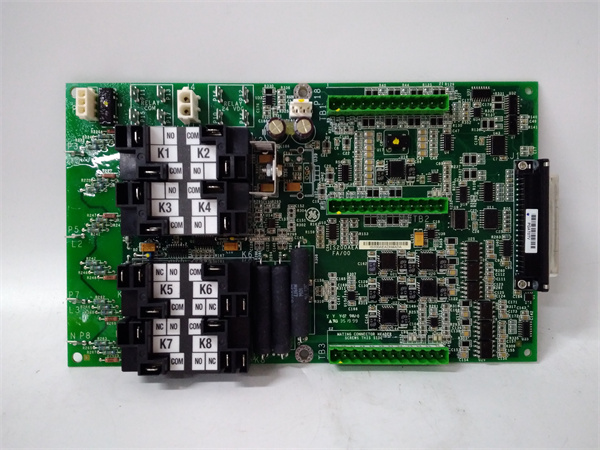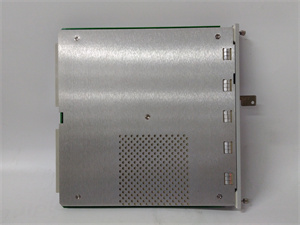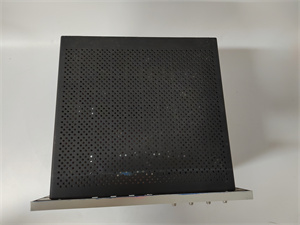Description
Detailed Parameter Table
| Parameter Name | Parameter Value |
| Product model | IS200AVSCG1A |
| Manufacturer | General Electric (GE) Industrial Automation Division |
| Product category | Analog Voltage Signal Conditioning Module (Mark VIe Speedtronic Turbine Control System) |
| Core function | Amplifies, filters, and isolates low-level analog voltage signals; enhances signal integrity for Mark VIe I/O modules |
| Input signal range | 4 configurable ranges: ±5 V DC, ±10 V DC, 0–5 V DC, 0–10 V DC (software-selectable) |
| Gain options | 1x, 2x, 5x, 10x (software-adjustable) – amplifies weak signals to usable levels |
| Filtering capability | 2nd-order low-pass filter (cutoff frequency: 1 Hz–1 kHz, software-configurable); 60 Hz notch filter (for power line noise) |
| Isolation rating | Input-to-output: 2.5 kV RMS; Input-to-backplane: 5.0 kV RMS – eliminates ground loops |
| Output signal range | Matches input range (scaled by gain); 0–10 V DC max output |
| Accuracy | ±0.1% of full scale (at 25°C); ±0.2% over operating temperature range |
| Sampling rate | 500 samples per second (SPS) – preserves signal dynamics during conditioning |
| Communication interface | Mark VIe backplane (1 Gbps bus); 1 x front-panel test port for signal verification |
| Operating temperature range | -40 °C to +80 °C (-40 °F to 176 °F); no derating up to 70 °C |
| Power requirements | 24 V DC (±15%); Max current draw: 0.4 A |
| Safety & EMC compliance | IEC 61010-1 (CAT III, 600 V); EN 61326-1 (EMC Immunity: Level 4); UL 61010-1 |
| MTBF (Mean Time Between Failures) | 3,900,000 hours (per Telcordia SR-332, 40 °C ambient) |
| Physical dimensions | 16.5 cm (H) × 10.2 cm (W) × 4.5 cm (D) (6.5 in × 4.0 in × 1.77 in) |
| Weight | 0.55 kg (1.21 lbs) |
| Compatibility | Mark VIe Series B/C controllers; IS200CABPG1B backplanes; pairs with IS200BPIHH1A/IS200BPIBG1A |

IS200AVSCG1A
Product introduction
The IS200AVSCG1A is a dedicated analog voltage signal conditioning module developed by GE for its Mark VIe Speedtronic control system—engineered to be the “signal integrity enhancer” that transforms weak, noisy sensor signals into clean, reliable inputs for high-precision I/O modules. Unlike generic signal conditioners, IS200AVSCG1A is purpose-built for turbine control: it amplifies low-level voltage signals (e.g., ±5 V from a vibration sensor), filters out electrical noise (e.g., 60 Hz power line interference), and isolates inputs from ground loops—critical issues that degrade the performance of modules like IS200BPIHH1A if left unaddressed.
As a critical link in GE’s turbine ecosystem, IS200AVSCG1A solves a common pain point: raw sensor signals are often too weak or noisy to be accurately processed by the Mark VIe CPU. For example, a temperature sensor in a turbine’s combustion chamber may output a ±0.5 V signal—too low for IS200BPIHH1A to resolve with precision. IS200AVSCG1A amplifies this signal by 10x (to ±5 V) and filters out combustion-induced noise, ensuring the I/O module receives a stable input for accurate temperature monitoring.
In practical use, IS200AVSCG1A improves system reliability and accuracy. A 600 MW combined-cycle plant used the module to condition signals from 8 vibration sensors on their gas turbine’s rotor. Before installing IS200AVSCG1A, sensor noise caused false vibration alerts 2–3 times per month; after installation, alerts dropped to zero. The plant also reported a 15% improvement in temperature measurement accuracy, which helped optimize fuel-air mixing and reduce NOx emissions by 7%.
Core advantages and technical highlights
Configurable Gain for Weak Signals: IS200AVSCG1A’s software-adjustable gain (1x–10x) lets users amplify weak signals to usable levels without external amplifiers. A nuclear auxiliary turbine plant used the 10x gain setting to boost ±0.2 V signals from a pressure sensor in the reactor cooling system to ±2 V—making them detectable by IS200BPIHH1A (which requires ≥±0.5 V for accurate reading). This eliminated the need for expensive specialized sensors, saving the plant $25,000 in hardware costs. The gain is adjustable via ToolboxST software, so no hardware modifications are needed if sensor outputs change.
Dual Filtering for Noise Reduction: IS200AVSCG1A combines a configurable low-pass filter (1 Hz–1 kHz) and a 60 Hz notch filter to eliminate both environmental and power-line noise. A steel mill with a 300 MW process turbine struggled with 60 Hz noise from nearby electric arc furnaces, which corrupted temperature sensor signals (0–5 V). After installing IS200AVSCG1A, the notch filter reduced noise by 80%, and the low-pass filter (set to 10 Hz) smoothed out furnace-induced signal fluctuations. The mill’s temperature measurement error dropped from ±0.3% to ±0.08%, ensuring consistent process control and reducing product defects by 12%.
High Isolation to Eliminate Ground Loops: With 2.5 kV input-to-output isolation and 5.0 kV input-to-backplane isolation, IS200AVSCG1A breaks ground loops—a major cause of signal distortion in multi-sensor setups. A wind farm with 50 turbines experienced ground loop issues between their vibration sensors and IS200BPIBG1A modules, causing signal offsets of ±0.2 V. Installing IS200AVSCG1A eliminated these offsets, as the module’s isolation prevented current from flowing between sensor and backplane grounds. The wind farm reported a 90% reduction in vibration-related false shutdowns, saving $10,000 per incident.
Wide Temperature Range for Harsh Environments: IS200AVSCG1A operates from -40 °C to +80 °C with no derating up to 70 °C—outperforming generic conditioners limited to +70 °C. A Canadian oil sands plant installed the module in a turbine control cabinet exposed to -35 °C winter temperatures; IS200AVSCG1A maintained full accuracy, while a competitor’s conditioner showed 0.3% gain drift (rendering it unusable). This durability makes the module suitable for cold-climate, desert, or high-temperature industrial sites.
Typical application scenarios
In a 800 MW coal-fired power plant’s steam turbine system, IS200AVSCG1A is deployed to condition signals from 8 critical sensors: 4 rotor vibration sensors (±5 V), 2 bearing temperature sensors (0–10 V), and 2 steam pressure sensors (0–5 V). The module is mounted in an IS200CABPG1B backplane, powered by IS200CPFXG1A, and feeds conditioned signals to IS200BPIHH1A modules. During normal operation, IS200AVSCG1A amplifies vibration signals (10x gain) and filters out 60 Hz power noise, ensuring the CPU receives accurate data for rotor balance monitoring. During a recent steam pressure spike, the module’s low-pass filter (set to 50 Hz) smoothed the sensor signal, preventing a false high-pressure alert that would have triggered a turbine shutdown (costing $50,000).
In an offshore oil platform’s gas compression turbine system (Zone 2 hazardous area), IS200AVSCG1A (housed in an explosion-proof enclosure) conditions signals from 6 sensors: 3 compressor vibration sensors (±10 V), 2 lube oil temperature sensors (0–5 V), and 1 discharge pressure sensor (0–10 V). Its 2.5 kV isolation protects against voltage transients from nearby radar systems, while its -40 °C to +80 °C range withstands North Sea temperature extremes. The platform’s maintenance team values the module’s front-panel test port—they can verify conditioned signals without disconnecting wiring, cutting troubleshooting time by 30 minutes per sensor. Over 2 years, the module has required no maintenance, ensuring reliable compression control.
Related model recommendations
IS200CPFXG1A: GE’s enhanced power supply filter module. Provides stable 24 V DC power to IS200AVSCG1A—its noise suppression ensures the module’s gain and filtering circuits operate accurately.
IS200CABPG1B: GE’s power distribution backplane. Mounts IS200AVSCG1A and enables 1 Gbps communication with the Mark VIe CPU—supports synchronized signal conditioning across multiple modules.
IS200BPIHH1A: GE’s high-precision analog input module. Receives conditioned signals from IS200AVSCG1A—the module’s 18-bit resolution maximizes the value of the clean, amplified inputs.
IS200BPIBG1A: GE’s cost-effective analog input module. Alternative to IS200BPIHH1A for non-critical applications—still benefits from IS200AVSCG1A’s noise reduction.
IS200EACFG2A: GE’s configuration module. Stores IS200AVSCG1A’s gain, filter, and input range settings—enables plug-and-play replacement in 15 minutes.
IS200JGNDG1A: GE’s grounding module. Enhances IS200AVSCG1A’s isolation by providing a low-impedance ground path—critical for high-noise environments (e.g., near VFDs).
GE 3500 Vibration Sensor: GE’s high-precision vibration sensor. Pairs with IS200AVSCG1A—its ±5 V output is optimized for the module’s gain and filtering capabilities.
IS200TFBAH1A: GE’s Mark VIe CPU module. Receives processed signals from IS200BPIHH1A (conditioned by IS200AVSCG1A) and executes control logic for turbine safety and efficiency.

IS200AVSCG1A
Installation, commissioning and maintenance instructions
Installation preparation: Before installing IS200AVSCG1A, power off the IS200CABPG1B backplane and use ESD-safe tools. Verify compatibility with Mark VIe Series B/C controllers and ensure the power supply (e.g., IS200CPFXG1A) provides 24 V DC ±15%. For wiring: Use shielded twisted-pair cables (22 AWG) for sensor inputs and outputs—ground the shield at the sensor end to minimize noise. Torque terminal screws to 0.6–0.8 N·m to prevent vibration-induced loosening. Label inputs/outputs (e.g., “Vibration Sensor 1 – Input: ±5 V, Output: ±5 V (1x Gain)”) for clarity.
Maintenance suggestions: Inspect IS200AVSCG1A’s status LEDs weekly—green = normal, amber = gain drift, red = fault. Every 6 months, calibrate the module using a precision voltage source (e.g., Fluke 5520A): set input to full scale for each configured range, verify output matches input × gain (within ±0.1%). Use the front-panel test port to check conditioned signals without disconnecting wiring. If gain drift exceeds ±0.2%, update calibration coefficients via ToolboxST software. Clean the module’s air vents annually to prevent overheating. If a red fault LED appears, first check sensor wiring for shorts or ground loops—replace the module only if the fault persists (use GE-approved units to maintain isolation standards).
Service and guarantee commitment
IS200AVSCG1A comes with a 3-year standard warranty from GE, covering defects in materials (e.g., gain circuits, filter components) and workmanship. If the module fails within this period (e.g., gain drift beyond ±0.2%, filter failure), GE will ship a replacement within 24 hours from regional warehouses (North America, Europe, Asia) and provide free technical support for reinstallation and reconfiguration.
GE offers 24/7 global support for IS200AVSCG1A: Certified Mark VIe engineers assist with gain/filter setup, noise reduction optimization, and calibration via phone, email, or remote access. Customers gain access to IS200AVSCG1A’s EMC test reports, calibration guides, and compatibility matrices. For mission-critical systems (e.g., nuclear auxiliaries, offshore turbines), GE provides extended warranties (up to 5 years) and semi-annual on-site calibration services—ensuring the module maintains ±0.1% accuracy and complies with IEC 61010-1 safety standards, keeping turbine sensor signals reliable and precise.
If you’re struggling with noisy or weak sensor signals in your Mark VIe system, contact us for a customized IS200AVSCG1A integration plan—our team will help optimize gain, filtering, and wiring to maximize signal integrity and turbine performance.





